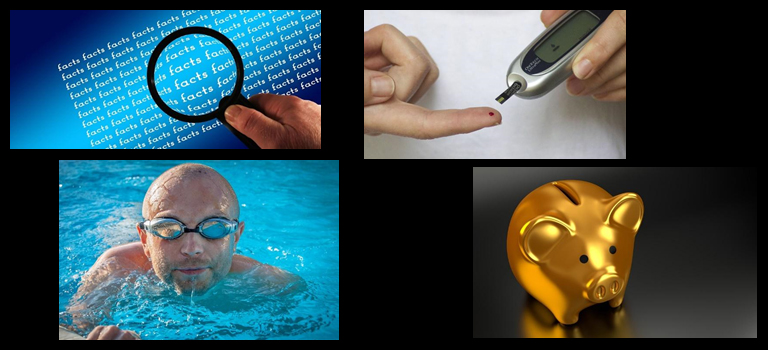With “nearly 2 million diabetes patients wearing Continuous Glucose Monitors today,”1 there is no doubt that this revolutionary device is changing the way of life for those living with the disease.
The first Continuous Glucose Monitor was approved by the FDA over 20 years ago.
Since that time, CGMs have proven to be an effective way to control blood glucose levels and manage diabetes.
Despite this, several questions and myths still revolve around the device.
At Quest Health Solutions, one of our top priorities is diabetes education.
In this article, we hope to uncover many of these myths and answer your questions.
What is a Continuous Glucose Monitor?
Before we begin, here’s a quick explanation of what a Continuous Glucose Monitor is and what it does.
A small electrode is placed under the skin and is held in place by an adhesive. A transmitter attached to the electrode sends data to a separate unit and takes readings on set intervals allowing a patient to record and access valuable information to help manage and control their diabetes. Patients can easily track daily patterns, ranges and targets and receive alerts when trending too high or too low. Prior to CGMs, the main way to test glucose levels was through a blood glucose monitor which requires frequent fingersticks.
Now on to debunking the myths surrounding these beneficial devices.
Uncovering CGM Myth #1 – Insertion is Painful
The good news is that a Continuous Glucose Monitor will reduce the number of painful fingersticks that are typically needed with traditional blood glucose monitors. Prior to the introduction of CGMs, that was the only way to monitor levels. Some patients do say “there is mild discomfort when first inserting the sensor, but there is no pain afterward.”2
Uncovering CGM Myth #2 and #3- No More Fingersticks Needed and CGMs are Inaccurate
While a CGMs significantly reduces the number of fingersticks required, there are certain times when they are needed to verify levels. Unlike a Blood Glucose Monitor, a CGM sensor actually takes readings from your interstitial fluid and not directly from the blood. Because the readings are from two different places, there is a natural lag between blood glucose levels in the interstitial fluid and glucose levels in the blood. Therefore, it’s normal, and should be expected, for the sensor readings and BGM readings to be different but for the most part they should be close.”3
Uncovering CGM Myth #4 – Sensor Can’t Get Wet and Can’t be Read Through Clothing
It is completely fine to shower and bathe and go about normal daily activities while wearing a Continuous Glucose Monitor. The sensor is water-resistant and can also be worn while swimming and exercising. It is recommended that “the sensor not be submerged in water deeper than 1 meter or kept underwater for longer than 30 minutes at a time. The reader, however, is not waterproof and should be kept nearby, and out of the water.”4 Results can also be read through clothing, including winter sweaters and jackets. The reader can collect data from the sensor within 1 to 4 cm of the sensor and can definitely be read through clothing.
Uncovering CGM Myth #5 – CGMs are Expensive
Today most major insurance companies now cover Continuous Glucose Monitors for Type 1 diabetes patients and those benefits are slowly starting to transfer over to Type 2 diabetes patients making the CGMs an affordable option for many patients.
Thanks to recent changes, Medicare now covers many CGM brands under the durable medical equipment category. A ruling made by the FDA, allowed certain CGMs to be seen as accurate enough to be used in treatment and dosing without requiring a fingerstick for confirmation. That allowed the doors to continue to open and Medicare coverage increased to include CGMs smartphone usage. Beginning in 2020, all but one CGM device on the market was covered. “As of October 2020, all CGM devices on the market with the exception of those from Medtronic Diabetes are covered by Medicare. These include the Dexcom G6, the Abbot FreeStyle Libre 1 and 2, and the implantable Eversense CGM from Senseonics.”4
Uncovering CGM Myth Bonus Tip – Continuous Glucose Monitors are Hard to Find
That’s one mystery we can help solve right now. At Quest Health Solutions, we can guide you through the entire process. We are not only one of the leading suppliers of Continuous Glucose Monitors in the market today, but we also offer CGM Fulfillment Solutions. Our experienced team will handle all of the paperwork, insurance coverage, Medicare verification, billing and authorization calls. To learn more or to find out how a Continuous Glucose Monitor can be part of the solution, contact us 1-877-888-7050 Option 3, Ext. 1011, email ben@questhealthsolutions.com or schedule an appointment today.
1. (2016) Medtronic. Five Myths of CGM available at Click Here accessed on 18 September 2021.
2. (2020) Novi-Health. Guide to Using Abbott FreeStyle Libre available at Click Here accessed on 20 August 2021.
3. (2021) Healthline. Medicare Loosening Restrictions for Continuous Glucose Monitor Coverage. Available at Click Here accessed on 20 September 2021.

